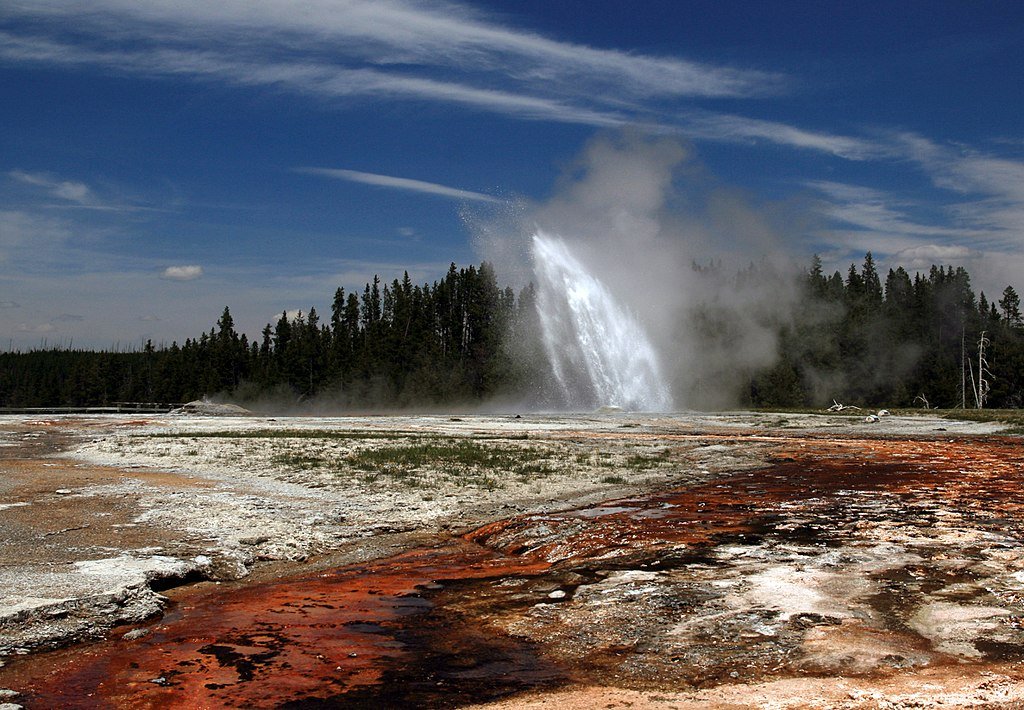Yellowstone National Park is famous for its geysers, bison, and breathtaking landscapes but scientists now believe it could hold the key to solving a modern resource crisis. Hidden beneath the park’s bubbling hot springs and volcanic activity may lie vast reserves of helium, an element critical for everything from MRI machines to quantum computing. What makes this discovery even more extraordinary? Unlike most helium deposits which are extracted as a byproduct of fossil fuel drilling Yellowstone’s helium could be carbon-free, a potential game-changer in the race to secure this vanishingly rare gas.
The Helium Paradox: Abundant in Space, Scarce on Earth

Helium is the second most prevalent element in the universe, but on our planet, it’s startlingly rare. Why? Unlike hydrogen or oxygen, helium doesn’t attach itself to other elements, it’s a lone traveler, floating off into space as soon as it hits the surface. What little helium we consume today is a byproduct of natural gas production, making its supply dependent on an industry the world is attempting to phase out.
But in 2016, scientists made a breakthrough, They found a vast helium reservoir in Tanzania that is utterly separate from fossil fuels. Then, in 2024, a Minnesota deposit was discovered, further establishing that “primary” helium reserves resulting from radioactive decay in ancient rock could be found in the unlikeliest of locations. Scientists are now looking to Yellowstone, where intense geothermal activity and billion-year-old rocks provide the ideal environment for helium build-up.
Why Yellowstone? The Geology Behind the Hunt

Yellowstone is positioned over one of the geothermally most active areas on the planet, with magma waiting just miles beneath the surface. This heat is essential for helium production because it releases the gas from ancient rocks where it’s been locked for millennia.
The park also lies within the Wyoming Craton, a geological formation containing rocks 3.5 billion years old, some of the oldest on the planet. These rocks are rich in uranium and thorium, elements that decay over millennia, producing helium as a byproduct. Normally, this helium stays locked inside minerals, but Yellowstone’s intense heat exceeds the “closure temperature” the threshold needed to release helium atoms from their crystalline prisons.
The Great Helium Escape: Why Yellowstone Itself Isn’t the Treasure Trove

While Yellowstone’s geology makes it a helium factory, the gas doesn’t stay put. The park’s underground plumbing, a maze of fractures and hydrothermal vents allows 66 tons of helium to leak out annually, enough to fill 1.3 million party balloons each year.
But here’s the twist: The surrounding regions might be trapping it. Just as Minnesota’s helium was found in ancient fault lines, scientists suspect similar deposits could be hiding in the rock formations bordering Yellowstone. If so, these reserves could be pure and fossil-fuel-free, making them an environmental and economic goldmine.
The Clean Helium Revolution: Why It Matters

Most of the commercial helium comes from natural gas wells, a process that releases CO₂ and fixes helium supply to the boom-and-bust fossil fuel market. Carbon-free helium, however, such as potentially near Yellowstone, could revolutionize the situation.
This gas is essential for:
- Medical imaging (MRI machines) : Liquid helium keeps superconducting magnets at near-absolute zero.
- Space exploration : NASA uses it to purge rocket fuel systems.
- Quantum computing : Superconducting processors rely on helium cooling.
- Nuclear fusion : Future reactors like ITER will need vast helium supplies.
If Yellowstone’s outskirts hold significant reserves, it could reduce reliance on foreign helium (the U.S. once stockpiled it in a Federal Helium Reserve, now depleted) and provide a sustainable alternative to fossil fuel-linked extraction.
The Future of Helium Hunting: A Global Search
The Tanzania and Minnesota discoveries proved that primary helium deposits exist—now, scientists are refining their search methods. The key is identifying regions with:
- Ancient, uranium-rich rocks (like cratons).
- Geothermal activity (to release trapped helium).
- Geological traps (faults or impermeable layers to contain the gas).
Yellowstone is just one candidate. Similar geothermal zones in Iceland, East Africa, and even Australia could be next. As researchers develop better detection techniques, the hunt for Earth’s hidden helium is only beginning.
Conclusion: A Race Against Time

Helium isn’t just for balloons, it’s a critical, non-renewable resource slipping through our fingers. With global demand rising and supplies dwindling, the discovery of clean, fossil-free helium near Yellowstone (or elsewhere) could be a scientific and industrial triumph.
For now, researchers are drilling into data, not dirt using advanced modeling to pinpoint where this elusive gas might be hiding. One thing’s certain: The next big helium strike could come from the most unexpected places. And if Yellowstone’s surroundings deliver, it might just save us from a looming helium crisis.
Final Thought:
Did you know the U.S. once had a 22-billion-liter helium reserve? It was sold off in 2023 making new discoveries even more urgent. Could Yellowstone’s hidden helium help fill the gap? Only time and science will tell.
Sources:

Jan loves Wildlife and Animals and is one of the founders of Animals Around The Globe. He holds an MSc in Finance & Economics and is a passionate PADI Open Water Diver. His favorite animals are Mountain Gorillas, Tigers, and Great White Sharks. He lived in South Africa, Germany, the USA, Ireland, Italy, China, and Australia. Before AATG, Jan worked for Google, Axel Springer, BMW and others.




